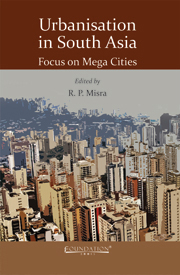Book contents
- Frontmatter
- Contents
- List of Figures
- List of Tables
- List of Contributors
- Introdution
- 1 South Asia: Land, People, and Economy
- 2 Historical Roots of South Asian Urbanisation
- 3 Mumbai: The Financial Capital of India
- 4 Delhi: Growing Problems of a Growing Megalopolis
- 5 Calcutta: The Emergence of Colonial Settlement into Megacity of the East
- 6 Chennai: A Rural Metropolis in Search of Modernity
- 7 Hyderabad: From the Feudal City to a Hi-Tech Metropolis
- 8 Bangalore: From Garden City to Silicon Valley of India
- 9 Karachi: The Commercial Capital of Pakistan
- 10 Lahore: The Cultural Heart of Pakistan
- 11 Kabul: A City in Perpetual Turmoil
- 12 Dhaka: A Mega City of Persistence and Change
- 13 Kathmandu: A City Where Tradition and Modernity Overwhelm Each Other
- 14 Thimphu: The City of Peace and Organic Development
- 15 Colombo: The Primate City of Sri Lanka
- 16 Male: Island Capital of an Island Nation
- 17 Beyond the Present: Vision of a New Urban Future
- Index
6 - Chennai: A Rural Metropolis in Search of Modernity
Published online by Cambridge University Press: 05 September 2013
- Frontmatter
- Contents
- List of Figures
- List of Tables
- List of Contributors
- Introdution
- 1 South Asia: Land, People, and Economy
- 2 Historical Roots of South Asian Urbanisation
- 3 Mumbai: The Financial Capital of India
- 4 Delhi: Growing Problems of a Growing Megalopolis
- 5 Calcutta: The Emergence of Colonial Settlement into Megacity of the East
- 6 Chennai: A Rural Metropolis in Search of Modernity
- 7 Hyderabad: From the Feudal City to a Hi-Tech Metropolis
- 8 Bangalore: From Garden City to Silicon Valley of India
- 9 Karachi: The Commercial Capital of Pakistan
- 10 Lahore: The Cultural Heart of Pakistan
- 11 Kabul: A City in Perpetual Turmoil
- 12 Dhaka: A Mega City of Persistence and Change
- 13 Kathmandu: A City Where Tradition and Modernity Overwhelm Each Other
- 14 Thimphu: The City of Peace and Organic Development
- 15 Colombo: The Primate City of Sri Lanka
- 16 Male: Island Capital of an Island Nation
- 17 Beyond the Present: Vision of a New Urban Future
- Index
Summary
Some years ago, academics referred to Chennai, earlier known as Madras, as a rural metropolis (Dattadri and Hyma, 1976), for the city and its people had radiated the charms of the rural landscape even as it was growing as a metropolis of some repute. Obviously, the rural metropolis of the 1970s has now graduated to become a ‘modern’ megalopolis. It is still suffused with a rural character underlying a more visible despoiled city. The physical and human environment has changed as the city has grown vertically as well as horizontally. The simplicity of life and compassion towards nature and fellow human beings that once formed the core of the urban culture of Chennai is, however, getting lost. This chapter looks at Chennai through time and space, the physical and socio-economic development ever since it appeared on the urban scene of India in the days colonial; it discusses the problems associated with it, it intends to lend a hand to planning and policy measures needed to make this metropolis growing yet better managed in future.
LOCATIONAL ATTRIBUTES
Chennai is located 13° 4' N and 80° 15' E on a flat plain slightly above the sea level. It stretches for about 30 km along the coast from Thiruvanmiyur in the south to Thiruvattiyur in the north. The elevation of the coastal topography rarely exceeds 5-7 metres. It is sultry and warm almost throughout the year. The months of December-February are fairy cool and pleasant. Being a coastal city, it is humid.
- Type
- Chapter
- Information
- Urbanisation in South AsiaFocus on Mega Cities, pp. 173 - 198Publisher: Foundation BooksPrint publication year: 2012



